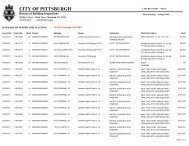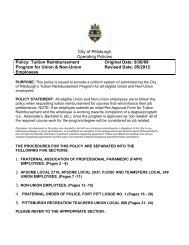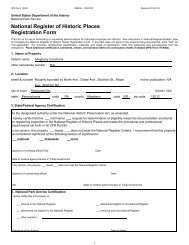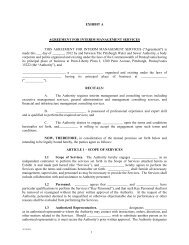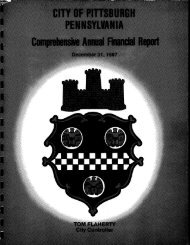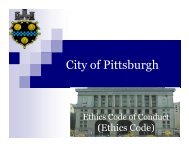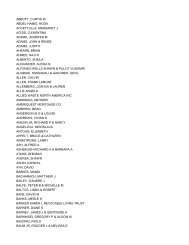east liberty station: realizing the potential - City of Pittsburgh
east liberty station: realizing the potential - City of Pittsburgh
east liberty station: realizing the potential - City of Pittsburgh
Create successful ePaper yourself
Turn your PDF publications into a flip-book with our unique Google optimized e-Paper software.
afternoon with about 1,250 vehicles per<br />
hour. The volumes are likely less than<br />
predicted due to some changes to <strong>the</strong><br />
development program, including projects<br />
like <strong>the</strong> Indigo Hotel which have not yet<br />
been realized. Even assuming <strong>the</strong> high<br />
estimate, a single traffic lane in each<br />
direction should be sufficient to handle<br />
<strong>the</strong> demand. Instead, Penn Avenue <strong>east</strong><br />
<strong>of</strong> Shady Avenue consists <strong>of</strong> two lanes<br />
per direction and <strong>the</strong> approaches to<br />
Shady Avenue are even wider, including a<br />
dedicated high-speed right turn lane from<br />
Penn Avenue to Shady Avenue.<br />
Clearly, <strong>the</strong> need for multi-lane arterials in<br />
East Liberty is dependent on <strong>the</strong> storage<br />
space for vehicles waiting at traffic lights.<br />
Conventional traffic engineering practice<br />
focuses primarily on <strong>the</strong> improvement to<br />
vehicular mobility; however, East Liberty is<br />
a true multi-modal node in <strong>the</strong><br />
transportation network, consisting <strong>of</strong> a highdensity<br />
pedestrian environment, numerous<br />
bicyclists, and serves <strong>the</strong> highest ridership<br />
busway <strong>station</strong> outside <strong>of</strong> Downtown.<br />
If East Liberty is committed to Transit<br />
Oriented Development, and creating an<br />
environment that encourages cooperation<br />
over competition, <strong>the</strong>n it should embrace<br />
<strong>the</strong> notion <strong>of</strong> capacity constraint. This is<br />
explained in <strong>the</strong> following paragraphs.<br />
Continuous optimization <strong>of</strong> traffic signals<br />
and lane configurations at intersections is a<br />
never-ending challenge for communities<br />
fortunate enough to be growing. The<br />
limiting factor in urban arterial road design<br />
is <strong>the</strong> intersection and not <strong>the</strong> number <strong>of</strong><br />
lanes between intersections. Flowing<br />
freely, a single travel lane can carry 1900<br />
vehicles per hour, but when interrupted by<br />
a traffic signal, <strong>the</strong> capacity <strong>of</strong> a lane<br />
typically falls to 600-800 vehicles per hour;<br />
thus it is <strong>the</strong> capacity <strong>of</strong> a road’s major<br />
intersections that dictates <strong>the</strong> number <strong>of</strong><br />
vehicles that can easily be accommodated.<br />
For <strong>the</strong>se reasons, we recommend that<br />
Penn Avenue from Collins Street to East<br />
Liberty Boulevard be reimagined as a<br />
multimodal corridor that places a greater<br />
emphasis on transportation system<br />
capacity over car capacity. Constraining<br />
car-carrying capacity will better utilize <strong>the</strong><br />
overall road network, encourage greater<br />
transit use, improve safety for all users,<br />
prioritize pedestrians and bicyclists, and<br />
provide an attractive environment for future<br />
land development opportunities.<br />
41



